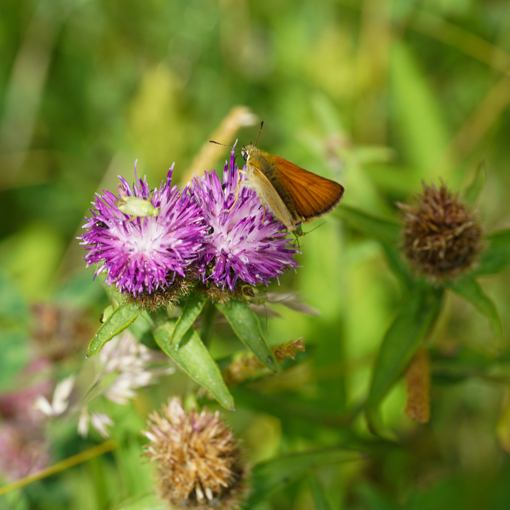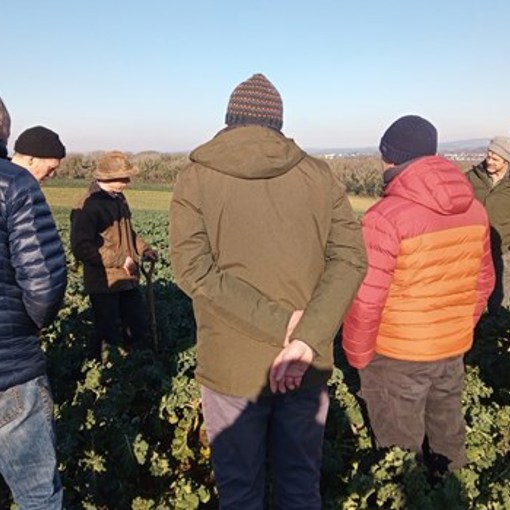The final loss of approval of Vydate, a pesticide used to control potato cyst nematode (PCN), on 31 December brings an AHDB-sponsored field lab into sharp focus as many potato farmers search for alternatives. Farmers in Shropshire and Lancashire are exploring the efficacy of growing trap crops to control the nematode.
“It’s even more pertinent to have biological pest controls with the loss of Vydate – we knew it was coming but maybe not so quickly. For 20 years I’ve been planning that part of my strategy will be to include a trap crop within our rotation across the farm,” said Neil Furniss, manager at M.E. Furniss & Sons in Shropshire.
How trap crops control PCN without pesticides
Trap crops work by deceiving PCN via chemicals they release which signal the presence of suitable food and trigger the nematodes to emerge from their safe hiding. Without a good source of energy to feed on, the nematode’s life cycle cannot be completed, reducing subsequent PCN populations in soils.
A combination of factors is causing growers to look more closely at biological management including high costs of chemical control measures, damage to soil life as well as the phase out of agrochemicals. The farmer-led trials commenced in summer 2020, with four farms supported with researchers through the Innovative Farmers programme.
“Members of this field lab were keen to work out what is the latest viable sowing date for the trap crops” explains Anne Stone, Knowledge Exchange Manager at AHDB Potatoes who are sponsoring the research. “In the immediate situation, growers can often move crops round so short season ones are grown on land low in PCN. But they then have to clean up infested fields, so there will be more interest in trap crops. They are more reliable than options like biofumigation but the best time to sow them clashes with the main growing season for cash crops, so as of yet, they are seldom grown.”
How the farmer led trial was structured
The Innovative Farmers field lab, sponsored and coordinated by AHDB Potatoes, is investigating two nightshade trap crop species - solanum sisymbriifolium and a less researched variety, solanum scabrum. The seeds, provided by Produce Solutions, were planted and compared at two different depths – approximately 1.5 and 3cm. They were drilled between cash crop harvest and planting dates to avoid the loss of the cash crop in the rotation, and drilling took place from early July to early August. Researchers from Harper Adams University, Curious Raven and OptiGro assisted with assessing trap crop cover, biomass and density and PCN soil counts.
First year results
The field lab found that establishment varied considerably between farms and concluded that planting in North Shropshire in late June has potential in lighter soils. At some sites, particularly on clay loam soils, weeds and soil moisture impacted establishment.
Furniss explains; “because of field lab, we know that in my area you have to get the trap crop seeded in the last week of June – 10th July latest, and it needs to be earlier in Lancashire. We’ve learnt a lot from working with the seed supplier and testing different species.”
Existing research indicates that S. sisymbriifolium needs to reach a certain biomass for effective PCN control, as it indicates a proportionate root system for effective PCN hatch. Although the plants at Neil’s farm didn’t quite reach this biomass, “I think that with longer rotations and trap crops, I can maintain low pest populations in the soil”, he said. “I’m trying to encourage other farmers in the area to do it; it’ll be the only way to control them in the future”.
“Trap crops have the potential to reduce PCN populations by up to 80%, but unless they can work between cash crops in the rotation, they won’t be seen as a viable option. By putting farmer priorities at the forefront of this research, the growers can properly risk assess whether they can make trap crops fit into the commercial practice. This sort of systems-based approach is what farmer led research is good at” said Kate Pressland, programme manager at Innovative Farmers.
Research continuing
The group will continue trials this year, exploring plant nutrition and PCN counts. “It is remarkable how much vim the Innovative Farmers field lab has added to trap crops for PCN”, Stone remarked.
They are also encouraging the inclusion of trap crops in payments for integrated pest management as part of the ELM scheme. The researchers presented the first year of findings at a recent AHDB strategic farm week, which can be re-watched here.
Get involved in your own farmer-led research
To keep informed of how this field lab and others are progressing sign up to our newsletter below.
Related news

16 November 2021
Nature friendly pest control
Farmers Treating Insects As ‘Livestock’ In Trial To Harness ‘Flower Power’ To Fight Pests

30 January 2023
Min till and cover crops
Strip-till in horticulture: Farmers and growers collaborate to solve unanswered questions

25 July 2022
Celebrating farmer-led research